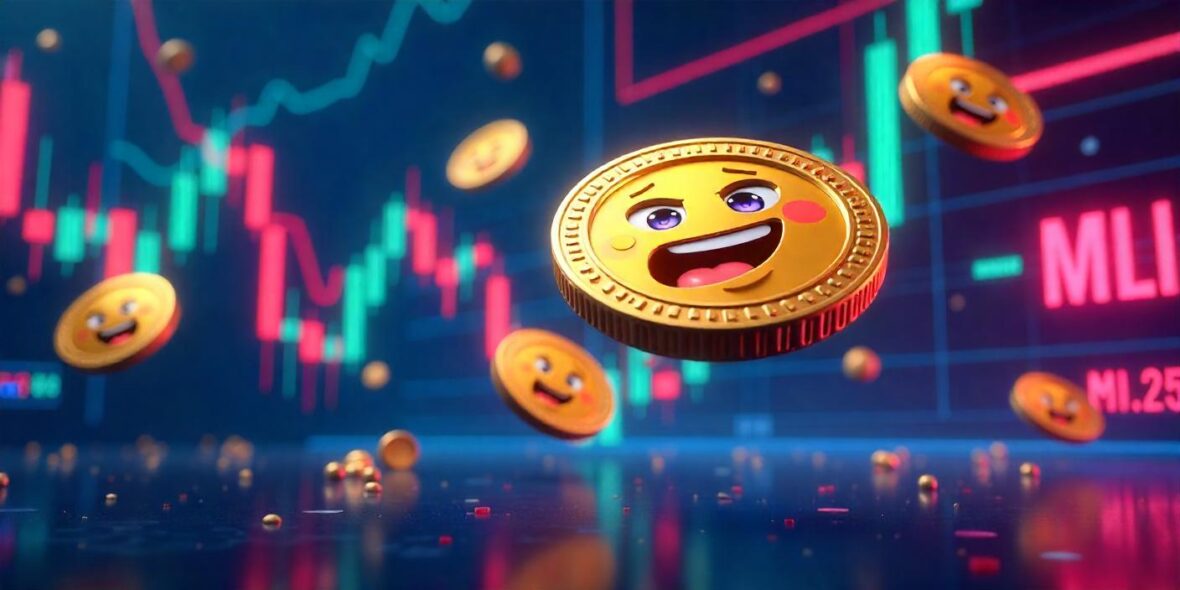Such crypto! So meme! Wow! Much bad investment. Amaze. Still go?
Not many people took cryptocurrencies seriously when they initially emerged — and that fact gets rather meta if you look at the phenomenon of memecoins. Dogecoin, the first-ever memecoin, is the case study here.
Launched in 2014 to ride on the hype of the popular Doge meme, its founders, software engineers Billy Markus and Jackson Palmer openly admit that they had one mission. To make their coin “as ridiculous as possible” and ultimately poke fun at Bitcoin.
Nobody’s laughing at Bitcoin anymore, but the fun (and undeniably volatile) side of crypto can be even more interesting. At the height of its popularity and relentlessly endorsed by Elon Musk, Dogecoin — the memecoin that sparked all other memecoins — was doing pretty well, too.
Are memecoins all fun and games (and, for that matter, a giant waste of money), or do they have the potential to become serious digital currencies in their own right? What actually is a memecoin? Should you get any? Tune in for answers to these questions and more — and, of course, to enjoy a laugh.
The Characteristics That Make a Memecoin
Let’s start at the beginning — because it’s impossible to define “memecoin” without first getting a grip on what a “meme” is. It’s broader than you might think.
Memes can be (and often are) default photo formats with text that often follows predictable rules, like the “blinking white guy,” “press F to pay respects,” “disaster girl,” “distracted boyfriend,” and of course, Doge.
That’s not all there is to memes, though. The American Heritage Dictionary defines a meme as “a unit of cultural information, such as a cultural practice or idea, that is transmitted verbally or by repeated action from one mind to another.” We’ll add that we think a meme also has to be both silly — often to the point of stupidity — and entertaining.
Dogecoin was based on an internet meme, and it’s not the only example of its kind. If, however, you agree with that definition of meme, you’ll also have to acknowledge that a memecoin doesn’t have to be built on a meme. It can become one.
For a cryptocurrency to be considered a memecoin, it has to have all of the following characteristics:
- The coin’s branding, logo, and marketing must be inspired by an internet meme or otherwise be funny and/or ironic.
- Memecoins have to be backed by a strong community. They can be community-created, or the community can come from the cult following of the cultural trend it was inspired by, but a community has to exist. Without it, aspiring memecoins are doomed to die before they even live.
- Memecoins have to be made for fun. Those who create and promote them don’t take them seriously. It’s all “for the lolz.” You buy memecoins for entertainment, not as a serious investment vehicle. (Although if you’re rich enough, like Elon Musk, that may involve spending a lot of money.)
Most memecoins are also initially worthless and highly volatile, but those things aren’t defining characteristics. Memecoins are cryptocurrencies based on a meme or with meme-like qualities, with the same purpose as a meme — entertainment. It isn’t complicated. That’s really all there is to it.
Memecoins vs Shitcoins: Is There a Difference?
Good question. The term “shitcoin” is a play on “Bitcoin.” It’s any altcoin (non-Bitcoin cryptocurrency) that’s worthless, pointless, and doomed to fail. While some Bitcoin purists would consider all altcoins shitcoins, true shitcoins aren’t just non-viable from the outset, but also incredibly volatile and often created as outright scams. Nonetheless, they usually amass enough of a following to get some attention before they disappear off the radar.
The “shit” part of “shitcoin” also shows up in another way. Shitcoins aren’t backed by credible development teams (and are, in fact, often released anonymously), are poorly developed, aren’t tradable in practice, and are often created with the explicit goal of inflating the price to make a quick buck before meeting their doom.
Memecoins can be shitcoins, and most start off with at least some of the characteristics of a shitcoin. As we’ve seen with Dogecoin, however, they’re not necessarily destined to stay that way. Even if they fail, they were created with a different intent. Memecoins may be worthless and doomed to fail, but they’re not pointless. Their purpose is to entertain.
What Kinds of Memecoins Are Being Traded?
Hop on CoinMarketCap — which devotes an entire section to memecoins — to find out for yourself! Dogecoin (worth $0.6371 at the height of its success to date) is undoubtedly the most famous memecoin, but so many others exist that you could spend all day exploring the market. And then some.
If you did, you’d see some clear themes emerge:
- Dog-themed memecoins make up the vast majority. Besides Dogecoin (DOGE), the dog section of the memecoin market includes Shiba Inu (SHIB), dogwifhat (WIF), Baby Doge Coin (BabyDoge), DOGS (DOGS), and countless others.
- Cats aren’t left behind, either. Popcat (SOL) (POPCAT), cat in a dogs world (MEW), Keyboard Cat (KEYCAT), and CatCoin (CAT) are all being traded right now.
- Celebrity coins are also a distinct category in the memecoin world. Some of the more famous ones include OFFICIAL TRUMP (TRUMP), Official Melania Meme (MELANIA), and lilpump (LILPUMP).
- AI-themed memecoins are picking up steam fast. They include Fartcoin (FARTCOIN), Act I: The AI Prophecy (ACT), and PepeAI (PEPEAI).
- Frog-themed memcoins mostly put Pepe in the spotlight, but besides Pepe (PEPE), you can also find BOOK OF MEME (BOME), Fwog (SOL) (FWOG), Pepe Unchained (PEPU), and countless others.
The memecoin universe doesn’t end here. We’re just getting started, but if that’s a rabbit hole you feel like jumping down, you’ll have to explore the rest of it on your own. Looking at the crazy coins people have created (and are actually trading) is a fun exercise. The question is, would you go a step further? Would you actually spend your hard-earned money, fiat or crypto, on one of these memecoins?
Why Do People Buy Memecoins? Are They Crazy?
That’s the million dollar (or one Bitcoin, as the case may be) question, isn’t it?
The answer is generally “no,” but with some caveats. Chances are that you know someone who’s bought a life-sized Darth Vader figure or some other vaguely similar ode to pop culture that’s equally devoid of practical value.
When justifying the purchase, this person might mention that the item could appreciate in value over time. “Some early Star Wars merch has sold for millions!” True as that may be, we all know that’s not why the Star Wars super fan laid money down for the figure. Buying pop culture merch is a hobby. More than that, it’s a hobby that marks you as part of a specific fandom — giving you a sense of belonging and de facto membership in an exclusive club. It’s all in good fun.
Memecoins are often backed by a similarly fanatic community. The decision to “invest in one” can center on the cult-like status a memecoin might develop over time, but it can just as easily be about an affinity with the meme it’s named after. If you like crypto and you also like Doge, you might, at one point or another, “diversify your portfolio” with some Dogecoin.
The verdict? Memecoins are part social contagion, akin to fidget spinners or the Marvel craze, and part hobby.
Most people who buy memecoins are not crazy. They’re having fun engaging in a side hobby. There’s a serious case to be made that you’re crazy if you genuinely believe that Snek (SNEK) or Dogelon Mars (ELON) will follow the same trajectory as Bitcoin — and that investing now will make you rich in the future. If that’s you, lock your wallet down and don’t open it again until you speak to an investment advisor and a psychologist. If, on the other hand, you’re just having a laugh, you simply belong to a growing group of internet nerds with a niche interest.
Should YOU Buy Memecoins?
Most memecoins have a “live fast, die young” trajectory and will eventually drop to zero. Even the success stories of the memecoin sphere, Dogecoin and Shiba Inu, are volatile to the point that investing in them is about as safe as investing in playing the slot machines at your local casino.
The question here isn’t if you should invest in memecoins, though. The question is if you should dabble in buying small quantities. The answer to that question can be “yes.” It all depends on what you’re hoping to get out of the experience.
Buying any amount of any memecoin is justifiable if:
- You’re 100% in it for fun — including showing your commitment to a particular fandom, satirizing the crypto market, or hoping to have a cool story to tell later.
- You’re not expecting to make a profit and are fully prepared to lose all the money you spent on memecoins.
- You’re spending very small amounts that you’re completely willing to lose.
It may also be justifiable if you’re a very experienced trader with an amazingly high risk tolerance and you have a rock-solid exit strategy that you’re prepared to activate at any moment. Risk tolerance is the key, here. You have to know what you’re getting into.
Know that many memecoins are just as scammy as shitcoins, and check the total supply, distribution, and development team even before buying memecoins purely for fun.
Do not buy memecoins under any circumstances if:
- You’d only do so with a vague possibility of a serious return on investment. (It’s probably not going to happen.)
- You think memecoins can be used as a payment method anywhere.
- The fact that memecoins aren’t an investment vehicle hasn’t quite sunk in yet.
- You don’t understand how crypto works in general.
The long and short of it? Memecoins are very volatile, usually doom-bound, and almost guaranteed to set you up for financial losses. They usually have no practical or real-world value, and memecoins that prove to be an exception won’t last long, either.
It’s never safe to buy memecoins. It’s always safer not to. If you’re OK with that, go ahead — but imbibe in moderation.
Can You Make Your Own Memecoin?
You bet, and it’s not that difficult, either, even if you have no coding experience at all. Most memecoins are nothing but new tokens on existing blockchains — like Solana, Ethereum, and the Binance Smartchain. Platforms like TokenMint let you create those, and smart contract templates also exist. Creating a liquidity pool that makes your coin tradable, and marketing the coin, is much harder, but the initial coin creation process is so quick and easy that you could do it during your lunch break.
That explains why so many memecoins that decidedly fall into the “shitcoin” category have flooded the market, but it doesn’t mean you should hop on the trend.
We do see some cool potential here. Launching a memecoin as part of a charity fundraiser could be quite amazing, for example, and creating a memecoin as an expression of your love for a fandom is also cute. Risky? Definitely. When the coin inevitably drops to zero, you could be left with your reputation in tatters and, as regulators start cracking down on crypto scams, in a heap of legal trouble.
A Final Word
Memecoins are fun at best and scammy at worst. They may be the most interesting side of the crypto market, but don’t be fooled — most memecoins don’t have the potential to turn into a serious investment vehicle, and you should never buy them in the hope of making a profit.
That doesn’t mean you won’t luck out. You might. Dogecoin proved that not every memecoin is equal. Even this darling of memecoins gets pretty close to rock bottom at times, though, and that’s really all you need to know.







